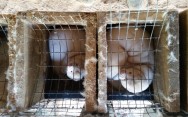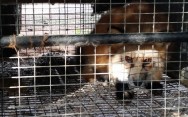Blog Archives
Home -
Posts tagged "Animal Abuse"
Despite some positive progress in legislation, puppy mills are still a big source of cruelty and neglect,
a fact that is all too real for thousands of dogs across the United States. The ASPCA’s recent poll
revealed that the most important issue for supporters in 2025 is fighting for stronger legislation to
protect puppy mill victims. Large-scale commercial breeding operations continue to operate under
outdated and inadequate regulations. People are beginning to wake up to the fact that this cruelty is
still legally sanctioned, but we are a long way from liberating dogs from puppy mills.
Puppy mills are notorious for their appalling conditions, with many dogs confined to tiny, wire cages
barely large enough for them to turn around. These facilities, which are regulated by the U.S.
Department of Agriculture (USDA), often fail to meet even the most basic welfare standards. Female
dogs are bred relentlessly, producing litter after litter without adequate time for rest and recovery.
Even with laws on the books, these standards are rarely enforced, and commercial breeders that
neglect their animals continue to operate unchecked.
Even the lucky ones who are adopted and rescued from lives of forced breeding have stories of
trauma, their bodies ageing faster than is normal for a well-cared-for dog. Read about the story of
Gracie, a dog who was rescued after 6 years of breeding 100 puppies:
https://www.humaneworld.org/en/blog/mama-dogs-story-why-we-do-work-we-do-stop-puppy-
mills
There have been recent wins, including the passing of the New York Puppy Mill Pipeline Act in
December 2024. This New York legislation bans the sale of cruelly bred pets in retail stores. The
ASPCA report outlines a commitment to building on this momentum by pushing for similar
legislation in other states in 2025. The ASPCA also advocate for Goldie’s Act, a bill that would require
the USDA to enforce stronger oversight of federally licensed facilities, ensuring more frequent
inspections, intervention for animals in need, and better coordination with local law enforcement.
The road to eliminating puppy mills is long, but with continued advocacy, we can reduce the
suffering of countless animals. The fight is far from over, and it’s imperative that we keep working
together to ensure that no dog ever has to endure the horrors of a puppy mill again.
Please read more on the ASPCA Website: https://www.aspca.org/news/poll-results-revealed-which- animal-welfare-initiative-was-voted-most-important-aspca-supporters
For more information about our work at Freedom 4 Animals to educate the public and push for
animal freedom, please click to read: https://www.freedom4animals.com/the-empathy- program/
|
Tags: Animal Abuse,
Animal Advocacy,
Animal Cruelty,
Animal Freedom,
animal rights,
ASPCA,
Commercial Breeding,
Forced Animal Breeding,
Gracie's Story,
Kevin Boileau,
Nazarita Goldhammer,
New York Puppy Mill Pipeline Act,
Puppy Mills,
USDA
Greyhound racing is a cruel sport. Deaths, injuries and exhaustion are the norm. The animals’ natural
speed and abilities are harnessed in this nonconsensual sport that brings in millions for the industry
and sports fans, but ruins dogs’ lives. The sport is so hard on animals, that many US states and some countries have banned it . New Zealand is poised to be the latest country that bans greyhound racing. In Ireland, greyhound racing still receives 20 million every year in funding.
Every year, dogs die, grist to the mill. In 2024, the death toll of greyhounds at Irish race tracks
increased by 60%. 96 greyhounds were either euthanized or died of a racing injury on Ireland’s racing tracks between January and the end of June 2024 in Ireland. In previous years 60 animals were euthanized or died of a track-inflicted injury during the same time period. It’s an unacceptable amount of deaths in a “so-called sport” that is funded by taxpayer money.
It’s almost impossible to imagine a sport where humans frequently die or push themselves so hard
that they are too worn out to even retire after the sport. Of course we don’t euthanize humans
when they are no longer useful. And even the most demanding or dangerous human sports are
pursued voluntarily, whereas animals are engaged in sports without their consent.
A spokesperson for Greyhound Racing Ireland explained the deaths away as a result of an increase of
dogs being raced in the country. This only makes it clearer that greyhound racing is a sport that
sends dogs to their death.
Animal Welfare advocates have repeatedly criticized the Irish government’s funding of greyhound
racing. Greyhound racing receives more guaranteed funding than any other sport in Ireland. The
obvious conclusion from this is that greyhound racing is big business for the country: it’s easy money
for an industry that doesn’t have to pay its athletes or guarantee their welfare.
In even worse news for Irish greyhounds, Irish greyhounds are being exported to India to participate
in an incredibly cruel craze that involves racing greyhounds against motorbikes. This open animal
cruelty, known as “motorbike lure coursing” races dogs to exhaustion and exposes dogs to the
danger of being mangled in an accident.Just like humans, animals are capable of amazing physical feats. They enjoy testing their abilities, being competitive and playing with other animals. However unlike humans, they are forced to engage in sporting activities without their consent. Until we can communicate with animals to understand their needs and desires, involving them in sporting activities that are cruel
and punishing is not sport – it’s animal cruelty. At Freedom 4 Animals we believe that animal freedom demands that we consider animals as beings of equal significance, with equally valid needs, desires and agency. Read more about our educational programs and animal advocacy.
Please sign the petition to stop horse-racing in Ireland.
South Dakota governor Kristi Noem has made headlines for boasting that she shot and killed her dog
in cold blood. Noem’s story was intended to paint her as a “no-nonsense” person who had no
problem doing what was necessary. In the same chapter, Noem also wrote about how she shot her
goat in cold blood. Public opinion shows that this has not worked out in her favor. The cold-blooded
killing of a companion animal who relied upon and trusted a human, apparently doesn’t look that
good to the public.
Dogs are human beings’ closest companions and our history has been symbiotic with them for
Millennia. Yet dogs are often the first victims of humans’ failure to take responsibility for this
relationship, as when dogs are euthanized if they attack another animal or a human, or appear to
pose a threat to property and safety. Poor training by human owners and misunderstanding of their dog companions instill trauma and aggressive behavior resulting in the dog’s misbehavior or failure to live up to human expectations.
In her autobiography, Kristi Noem shared how she shot a 14 month old wirehaired pointer named
Cricket who had come to her family with behavioral problems. Noem went as far as to say that she
“hated” the dog. She made no attempt to deal with her own feelings. Instead, her dog Cricket,
immediately became responsible for how she felt, justifying Noem’s execution of the dog. The story
was intended to convey that Noem was a tough person who understood life in rural America. Her
lack of remorse for the killing simply revealed that Noem didn’t care about the dog’s life.
Noem shot her dog Cricket after Cricket prematurely chased birds on a pheasant hunt, then jumped
out of Noem’s truck and mauled chickens on a neighbor’s property. Cricket was free to attack the
chickens, because Noem had failed to secure Cricket in the truck. Successful dog trainers and experts
agree that a dog’s behavior and conduct is the responsibility of the owner, and dogs who misbehave
can behave better with different interventions and understanding.
People who have dogs and other animals as companions have a responsibility to
their pets to act with empathy and patience. Neglect and cruelty affect a dog’s behavior as much as
they do humans. At 14 months old, Cricket was a young dog, a puppy, who deserved care and
guidance. Instead, her life was cut short by her care takers disregard for her life.
The backlash against Noem’s story shows that people will no longer accept a narrative that
blames animals for human issues. We must make a choice to extend our compassion to
other animals, beyond companion animals like cats and dogs. Cricket made headlines, but Noem also
shot her goat. No animal should have to take responsibility for an abusive human’s behavior by
paying the ultimate price.
Using hidden cameras in agricultural facilities is still one of the best ways to reveal the horrific cruelty of industrial agriculture. This is why states continue to pass “ag gag” laws to restrict and punish any exposure of practices at agricultural facilities.
An animal rights group, Mercy for Animals, used hidden surveillance to protest Senate Bill 16 in Kentucky, which aims to criminalize the use of recording equipment such as drones, cameras, video recorders, audio recorders etc. inside concentrated animal feeding operations. In doing so they exposed exactly the reason why criminalizing these practices shields violence and cruelty from the public eye.
Workers are known to abuse animals horribly at industrial agriculture facilities, and the farms that Mercy for Animals exposed were no exception. The group released videos showing workers kicking, stepping, throwing and stuffing chickens into cages for transport. The farms are described as contract farms providing chicken to Pilgrim’s Pride, one of the largest chicken producers in the United States.
Large industrial farms continue to claim that animals are killed humanely, and any problems are the result of bad apples. But the scale of cruelty and killing at these farms reveals that it is the norm for workers to dehumanize animals and abuse them before killing them. This is part of a psychological process that is not separate from industrial farming, it’s normalized by workers exposed to violence every day as part of their job. Animal rights groups continue to expose these conditions, and the farming groups protest that the problem is the individuals involved, and not the industrial scale of the killing operation itself.
One of the key tools animal rights activists have at their disposal is drones, which are cheap and capable of recording poor conditions, animal abuse and illegal hunting. Footage captured by drones has led to many successful campaigns on behalf of animals.
If blocking surveillance of animal rights abuses were just protecting private property, why is it that industrial farming interests are always behind these laws? The cruelty that we see on footage obtained by animal rights groups is clearly a fraction of what actually exists. We must continue to fight for the right to expose horrific cruelty and the lies of the industrial farming industry.
Spain’s new animal rights law has notable exceptions that teach us a lot about how people view animals.
Spain has made it illegal to leave pets alone. Wild animals have been banned from the circus and marine parks are not allowed to keep any new dolphins in captivity that haven’t already lived in the marine park for most of their lives. Pets can no longer be bought from pet-shops or online. Only licensed breeders can sell pets. Mandatory pet insurance and registration is also required.
One of the quirks of the law is that it leaves out certain animals that feature in cultural activities in Spain. Hunting dogs are excluded from the legislation after the hunting lobby fought for the exception. Bullfights are also left out of the legislation, despite being one of the cruelest sports involving animals.
Bullfighting involves stabbing a bull with lances to weaken the animal, then eventually killing the bull. The bull is led into the ring, greeted by a matador, then jabbed by picadors and usually killed by the matador. The “sport” consists of introducing an animal to an extremely stressful situation– a ring with a large cheering audience — baiting and disorienting the animal, wounding it, then killing it. It is an activity that animal rights activists have long fought against. It is losing favor with the public even in places like Spain where bullfighting is traditional. Leaving it out of a sweeping animal rights law is arbitrary and caters to humans, leaving animals to suffer.
The fact that these exceptions are left standing says a lot about how humans prioritize the beings who are worthy of dignity and protection. Working animals, lab animals or animals like invertebrates are often left out of animal rights laws. Animal protection is still a cultural exercise enacted by humans who feel a closer relationship with some animals than others due to tradition, culture and the extent to which humans recognize traits of themselves in the animal. Many of the provisions in Spain’s animal rights law have been welcomed by activists, but the law does not yet achieve the goal of animal rights, which is to treat animals as if they have equal rights to humans, and each other.
|
Tags: Animal Abuse,
Animal Cruelty,
Animal Equality,
Animal Neglect,
animal rights,
Animal Rights Law,
Bullfighting,
Hunting,
Kevin Boileau,
Pets,
Transhumanism,
Working Animals
The question of whether it should be legal for people to rescue animals from slaughter houses and industrial farms is the subject of a recent New York Times op-ed.
It’s a question that deserves serious consideration. Animal activists have forced the public to confront these questions by filming conditions in slaughterhouses and industrial farms. Their reporting has revealed conditions of unimaginable horror and cruelty, and it has confronted us with our obligation not to be bystanders.
If you are aware of animal abuses committed at large agricultural facilities or slaughterhouses it’s not that simple to do something, however. If concerned citizens want to step in and rescue animals they can face serious charges. The NYT op-ed focuses on the actions of activists at DxE (Direct Action Everywhere) who have gained access to slaughterhouses and revealed abominable treatment of animals. In this case, the activists witnessed chickens at Foster Farms facility who were killed in violent haste. The activists’ infrared cameras showed live birds thrown, crushed and suffocated under piles of dead birds. Many weren’t stunned properly before being killed. There were other reports from U.S. Department of Agriculture inspectors of birds that had been dunked alive in a boiling water tank for defeathering. The activists rescued several animals from the plant, and there are other cases where activists have stepped in and rescued animals from industrial farming facilities and slaughterhouses.
The NYT op-ed made the point that if you saw someone boiling animals alive in your neighborhood, you would feel an obligation to step in and rescue the animals. Why is it any different at a Big Ag facility? There are laws that allow people to rescue dogs from hot cars, yet rescuing animals from cruel industrial farms is charged as theft, and filming the scenes of cruelty can be charged as criminal trespass.
Many of the activists say they are happy to stand trial to help set new precedents for animal rescue. This can pay off, such as in the case of a Utah jury who acquitted two activists of burglary and theft for taking two sick piglets from a Smithfield Farms facility.
This is just the beginning of a process that is stacked against Good Samaritans who want to rescue animals who are being treated cruelly. The bigger problem is that the industrial farming and meat industry will continue to commit cruelty as a matter of course. Industrial farming and the meat industry have sacrificed animal lives to the production line. Rescuing animals from these conditions is the first step towards making society confront what the appetite for industrially farmed meat means for animal lives.
|
Tags: Ag Gag,
Animal Abuse,
Animal Cruelty,
Animal Rescue,
animal rights,
Animal Rights Activists,
Chickens,
Factory Farming,
Kevin Boileau,
Nazarita Goldhammer,
Transhumanism
The FDA is finally catching up with animal rights advocates. A new law signed by President Biden at the end of December reflects the reality that testing on animals is cruel, and – ironically – unscientific. The FDA Modernization Act 2.0 ends the requirement that drugs in development must undergo testing in animals before being given to participants in human trials.
Animal Testing is Unreliable
Animal testing has been found to be an unreliable predictor of toxicity in a large range of drugs. The FDA Modernization Act makes way for new methods of animal testing such as testing cells grown on chips, or organoids, organized cell tissue mimicking human organs. Data modeling has also been shown to help predict human reactions to drugs. Animal testing is a slow and tortuous process. The lab animal trade imports animals like monkeys into the US to be caged and tested by being implanted with diseases like cancer. The suffering the animals endure is intense and unconscionable. In our recent blog, we discussed how Elon Musk’s Neuralink has been using rhesus macaques in botched experiments that have caused painful injury and death. The “forward thinking” company has been needlessly killing animals and operating under a “move fast and break things” policy which has resulted in animal suffering more than it has produced results.
Animal Suffering is Not Yet Over
The FDA Modernization Act does not yet make animal testing illegal. There is a long way to go before the suffering of lab animals is over. It’s estimated that around 50 million animals are used in lab experiments in the US each year. A large majority of the animals are highly intelligent and social animals who can understand what’s happening to them and witness the suffering of their peers.
What You Can Do
The FDA’s New Law makes it more likely that states will move to ban animal testing on cosmetics and more, as New York just did. It’s important to maintain pressure on local representatives to change the law. You can also help by boycotting all companies that test their products on animals. Apps such as “cruelty cutter” and “Bunny” can help you to vet the products you are buying to check if they are cruelty free.
Elon Musk is not exactly the world’s most liked figure. One more reason for negative publicity is the revelation that Neuralink, a startup Musk founded in 2016, has killed 1,500 animals since 2018. Allegedly many of the animals suffered horribly from botched experiments.
The animals in question are rhesus macaques who were undergoing experiments by the company to develop a brain chip implant that Neuralink claims could one day help paralyzed people to walk and blind people to see. Beyond the dazzling scientific pitch for this device, there are horrific reports of animals who had their skulls breached to implant the experimental device, and in one case (according to public records) gaps in an animal’s skull were filled with an unapproved adhesive which caused the animal to hemorrhage. In another case a monkey had nausea so severe she had open sores on her esophagus before she was killed. Animals suffered from chronic staph and other infections after having the brain chip implanted.
Other evidence for this horrific treatment is an impassioned internal letter written by an employee concerned about the need to slow down the pace to avoid “hack jobs” on the animals during the experimental surgery. The “break things and move fast” speed has been blamed for the company’s cruel and cavalier treatment of animals. Elon Musk apparently told employees at Neuralink to work “as if they had a bomb strapped to their head.”
The USDA Inspector General has opened a probe into potential Animal Welfare Act violations at Neuralink. This is not a common occurrence, as research standards are often left to institutional Animal Care and Research bodies at universities. The Animal Welfare Act doesn’t adequately protect many animals in the first place. Companion animals and other animals held in captivity have more protection than animals used in agriculture, mice and rats. Overall protections for animals used in research are inadequate.
The USDA probe suggests something has gone horribly wrong with the treatment of animals at Neuralink. Animals have become a casualty not only of a culture that disregards animals, but also of a capitalist, disposable culture of speed and greed.
Animal rights will never be a concern so long as we live in a culture where meeting production schedules are more valuable than life. In this culture, everyone is the product – whether it’s humans or defenseless research animals. Because animals can’t speak for themselves, we allow the abuse of research animals to continue. Paying attention to stories like this can help us stay alert to the violent realities of animal research and hold everyone involved accountable.
Among the saddest and most cruel forms of torture animals humans have inflicted on animals is Bear Bile Farming. Bear Bile is used in traditional Chinese medicine. The process of extraction involves starving and dehydrating bears and extracting the bile through catheters and needles inserted into the gallbladder. Worse still, the bears are captured and confined to produce bear bile for the duration of their lives. This could mean up to 30 years of torture.
In the past, bears were killed and their gallbladders removed. Since the 1980s, the practice of bear bile farming took off. There are many synthetic and plant based alternatives that could replace this cruelly sourced extract, however bears are still kept in tiny cages for their whole lives to allow the extractions to take place. Bear bile farming is still legal in many countries. Korea, for example, still allows bear bile farming, though it has pledged to put a stop to it by 2025.
Vietnam is one of the countries that has banned bear bile farming but bear bile farms still exist there under the radar. It was on one of these farms that Paddington Bear, a moon bear, was kept for 17 years in a tiny cage where she was dehydrated and starved and her bile extracted. She was rescued by Animals Asia, but unfortunately she died less than a month after her rescue. Paddington Bear was dehydrated when she was rescued and suffered from multiple health problems typical of bears who are farmed for bile. These bears are often captured when they are bear cubs. They witness their mothers killed by poachers and are kept on bear bile farms for their whole lives where they are isolated and confined to the point that their bodies grow stunted to fit their tiny cages. Throughout their lives, they are tortured routinely with cruel bile extraction. The extraction of the bile leaves bears in poor health and causes many diseases and malignant tumors.
Paddington Bear was so close to living a better life, freed from the farm where she spent 17 years. Unfortunately, her health problems were overwhelming. She didn’t get to enjoy a healthy, peaceful retirement at her new home, but with renewed efforts to end the practice of bear bile farming, other bears may never have to go through what she did.
To learn how to end bear bile farming and help to rescue bears kept on bear bile farms, please visit Animals Asia’s website:
https://www.animalsasia.org/us/media/news/news-archive/five-things-you-need-to-know-about-bear-bile-farming.html
|
Tags: Animal Abuse,
Animal Cruelty,
Animal Rescue,
animal rights,
Animals Asia,
Bear Bile Extraction,
Bear Bile Farming,
Kevin Boileau,
Nazarita Goldhammer,
Transhumanist,
Wild Animals
The manatee was swimming around in Florida’s waters, when Trump supporters lured, then detained the animal to scratch a slogan into the animal’s back. The Trump supporters etched the word “Trump” into the algae on the manatee’s back. It was an act that must have taken a while to complete. The letters were 12-14 inches in height. The animal was discovered within days of the Capitol insurrection
Even though the animal appears to have been unharmed, we don’t know what harassment took place while the animal was detained. It’s possible that the animal didn’t resist because it was hurt or injured. The idea that an animal is nothing more than a billboard, a lifeless prop humans can etch slogans onto is what makes this incident horrifically disturbing. The animal was harassed, violated but more generally, it was made to stand for a human ideology that has no concern for any obstacle that stands in its way, even if that obstacle is a living being.
A “hands off” approach in Florida means that people are prohibited from harassing manatees – ie chasing, touching or riding. After this incident, there have been calls for a strict 100 percent hands off rule for approaching manatees. Human behavior towards animals clearly shows it’s not always in animals’ best interests to trust humans.
The figures show that animal abuse and human abuse is a revolving door. Domestic abusers abuse dogs and companion animals. Serial killers start with small animals. We must never make the mistake of seeing the suffering of any living being as meaningless. Violence is violence. The entitlement of the people involved in harassing this living creature only communicates the hideous violence of the Trump ideology and its lack of regard for any creature that gets in its way.
https://edition.cnn.com/2021/01/12/us/manatee-with-trump-on-its-back-trnd/index.html
https://www.miamiherald.com/opinion/op-ed/article248668315.html








Social Media